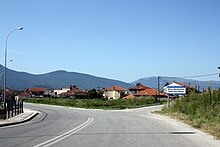Kato Nevrokopi
Kato Nevrokopi
Κάτω Νευροκόπι | |
|---|---|
Settlement | |
 | |
| Country | Greece |
| Administrative region | East Macedonia and Thrace |
| Regional unit | Drama |
| Population (2011)[1] | |
| • Community | 2,157 |
| Time zone | UTC+2 (EET) |
| • Summer (DST) | UTC+3 (EEST) |
| Vehicle registration | ΡΜ |


Kato Nevrokopi (Greek: Κάτω Νευροκόπι "Lower Nevrokopi", [Зърнево, Zarnevo] Error: {{Lang-xx}}: text has italic markup (help)) is a municipality and town within that municipality in the northwest section of the Drama regional unit, Greece. Before the 2011 local government reform, it was the largest municipality in all of Greece, covering an area of 873.552 km² (337.28 sq mi). The 2011 census reported a population of 7,860 inhabitants.[1] The region is known for the very low temperatures during the winter and for its famous agricultural products such as potatoes and beans. The area has several features to attract tourists: the ski center of Falakro, the traditional settlement in the village of Granitis (pop. 78), the historical bunker of Lise, the artificial lakes of Lefkogeia and Potamoí, the spectacular routes in the forests, the old churches. The forest paths offer excellent views to hikers. The largest towns are Kato Nevrokopi (the municipal seat, pop. 2,157),[1] Volakas (1,028), Perithorio (898), Lefkogeia (465), Kato Vrontou (554), and Ochyro (514). On the territory of the municipality are located several abandoned villages, including Monastiri and Mavrochori.
History
Under the Ottoman Empire, the village was predominantly settled by Bulgarians, with small numbers of Turks and Vlachs. Following the Asia Minor Catastrophe and the subsequent population exchange, it was settled by large numbers of Greek refugees from Asia Minor. In 1927, its name was changed from [Ζύρνοβο (Zyrnovo, Зърново)] Error: {{Lang}}: text has italic markup (help) to Kato Nevrokopi,[2] after the neighbouring town of Nevrokop (present Gotse Delchev) in Bulgaria. On 18 April 1945, during fighting related to the Greek civil war, many Slavic inhabitants left the area. Many of them resettled in Štip, today in the Republic of Macedonia.
Notable people
References
- ^ a b c "Απογραφή Πληθυσμού - Κατοικιών 2011. ΜΟΝΙΜΟΣ Πληθυσμός" (in Greek). Hellenic Statistical Authority.
- ^ Name changes of settlements in Greece


